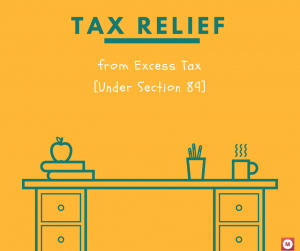
Tax rates vary from year to year.
Suppose a year’s income with low tax rate get taxed in a year of a high tax rate than the taxpayer ends up paying more taxes.
Isn’t it unfair?
To remove this burden from salaried taxpayers a tax relief under section 89 was introduced.
Which says that if an individual receives any portion of his salary in arrears or in advance or receives profit in lieu of salary, he can claim tax relief (u/s section 89 read with rule 21A)
Applicability of Tax Relief
Following are the situations where tax relief under section 89 can be claimed:
- Salary of more than 12 months received in advance or arrears
- Profits in lieu of salary like provident fund is received [ u/s 17(3)]
- Family pension received in arrears by any family member on the death of an employee
Exceptions: Situation where tax relief is not available
Under following situations tax relief u/s 89 is not available if exemption under section 10(10C) already claimed:
- Voluntary Retirement Scheme (VRS)
- Termination of Service under any schemes of voluntary retirement
- Scheme of Voluntary Separation
Calculation of Tax Relief under Section 89
Basically, the calculation of relief under section 89 is arithmetical.
To get that we need to find out two amount income tax for a particular year.
The first is the tax amount on the total income including the extra salary amount.
The second is the tax amount on the total income without the extra salary amount.
I will guide you through the entire process step-by-step.
Computation of relief when salary has been received in arrears or in advance [21A(2)]
The relief of additional salary received as arrears or advance is computed in the manner laid down in rule 21A(2) as under:
Step #1:
Calculate the tax payable on the total income, including the additional salary, of the relevant financial year in which the same is received.
Step #2:
Calculate the tax payable on the total income, excluding the additional salary, of the relevant financial year in which the additional salary is received.
Step #3:
Find the difference between the tax at step#1 and step#2.
Step #4:
Compute the tax on the total income after including the additional salary in the financial year to which such salary relates.
Step #5:
Compute the tax on the total income after excluding the additional salary in the financial year to which such salary relates.
Step #6:
Find out the difference between tax at step#4 and step#5.
Final Step #7:
The excess of tax computed at step #3 over tax computed at step #6 is the amount of relief admissible under section 89.
No relief is, however, admissible if tax computed at step #3 is less than tax computed at step #6. In Such a case, the assessee-employee need not apply for relief.
If the additional salary relates to more than one financial year, the salary would be spread over the financial years to which it pertains in the manner explained above.
Example
Mr. Mohan, a salaried employee aged 46 years,
During the financial year 2017-18 [AY 2018-19], received Rs. 10,67,000/- as basic salary and Rs. 20,000/- as arrears of bonus of the financial year 2009-2010.
During the financial year 2009-2010 [AY 2010-11], he had received Rs. 5,00,000/- as basic salary.
Calculate relief under section 89 for Assessment Year 2018-19.
Solution
The admissible relief under section 89 in respect of bonus paid in the financial year 2016-17 will be computed as under:
[I have used tax calculator provided by the department for calculation in each step]
Step #1:
Tax on total income* of Rs. 10,87,000/- for AY 2018-19 [year of recpiet] is Rs. 1,42,758/-
*including arrear bonus of Rs. 20,000/-
Step #2:
Tax on total income* of Rs. 10,67,000/- for AY 2018-19 [year of recpiet] is Rs. 1,36,578/-
*Not including arrear bonus of Rs. 20,000/-
Step #3:
Difference between step #1 and step #2 is Rs. 6180/-
[142758-136578]
Step #4:
Tax on total income* of Rs. 5,20,000/- for AY 2010-11 [year to which bonus relates] is Rs. 61,800/-
*including arrear bonus of Rs. 20,000/-
Step #5:
Tax on total income* of Rs. 5,00,000/- for AY 2010-11 [year to which bonus relates] is Rs.55,620/-
*Not including arrear bonus of Rs. 20,000/-
Step #6:
Difference between step #4 and step #5 is Rs. 6180/-
[61800-55620]
Final Step #7:
The tax at step #3 is equal to the tax computed at step #6.
So, in this case, tax relief will be zero.
File Form 10E: To claim Relief From Tax
To claim tax relief, a taxpayer should electronically File Form 10E.
This form needs to be filed before filing income tax return.
To do this, you need to login to e-filling website.
Then go to “e-file” tab > “Income tax Forms” > select form 10E, assessment year in which additional salary is received, submission mode and press “Continue” >
Now, you can file form 10E.

For TDS deduction on salary, your employer may ask for the acknowledgment of submission of Form 10E before adjusting your taxes and allowing tax relief.
After return filing, to prove your relief claim, you may be asked by the tax authorities to submit few documents like salary slip, bank statement, the tax return of prior periods etc.
Happy Saving!
About Author

Pravin Giri
(@Pravin) Twitter | FacebookPravin is a Qualified Chartered Accountant [CA]. Gives opinions on Income tax, GST, and finance.Find him on Twitter @Pravinkumargiri
Popular topicsIncome tax Income from other sources Deduction Salary Personal Finance Senior citizen House Property Capital Gain TDS GST Companies Act GST FAQ TCS





